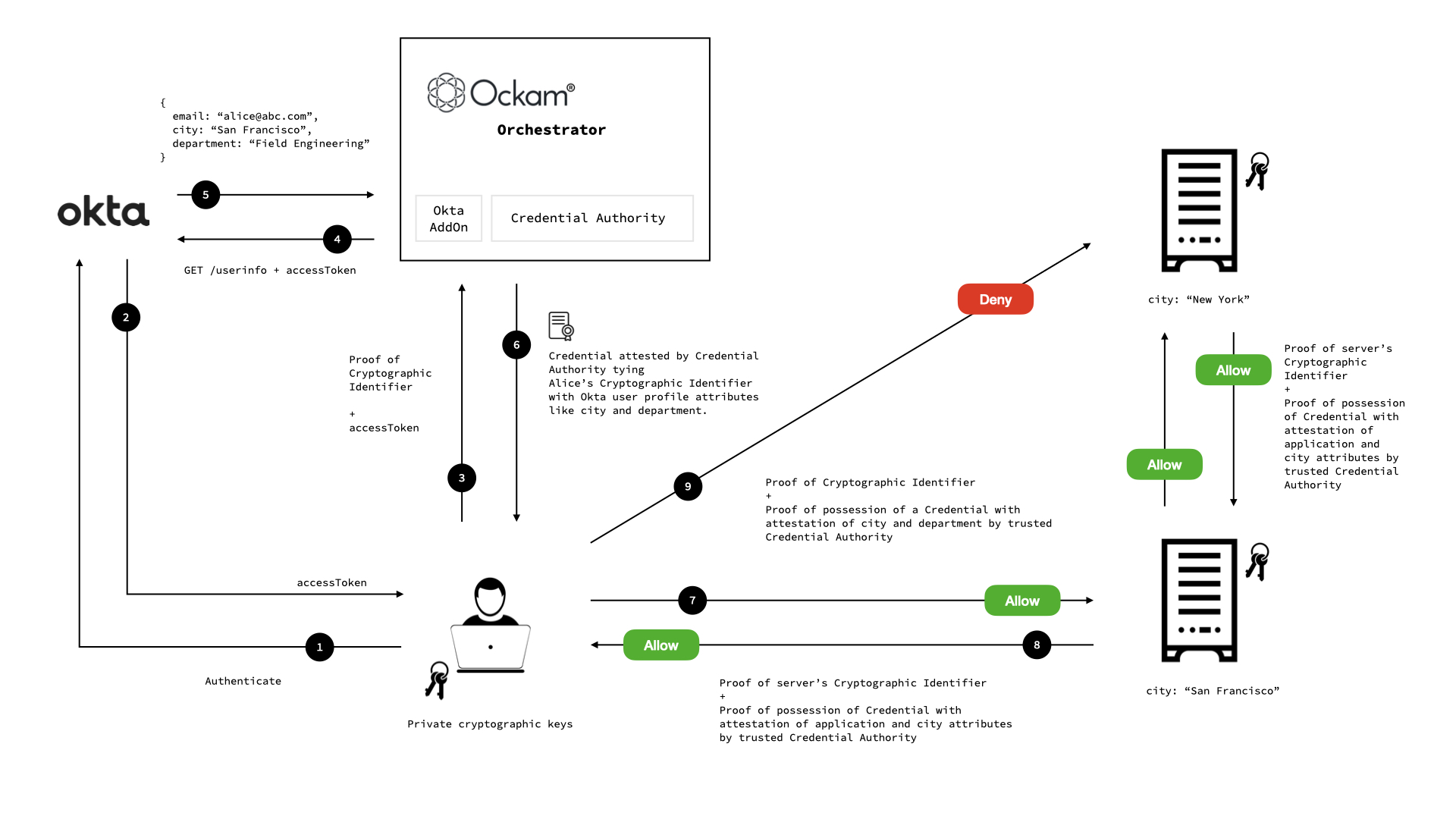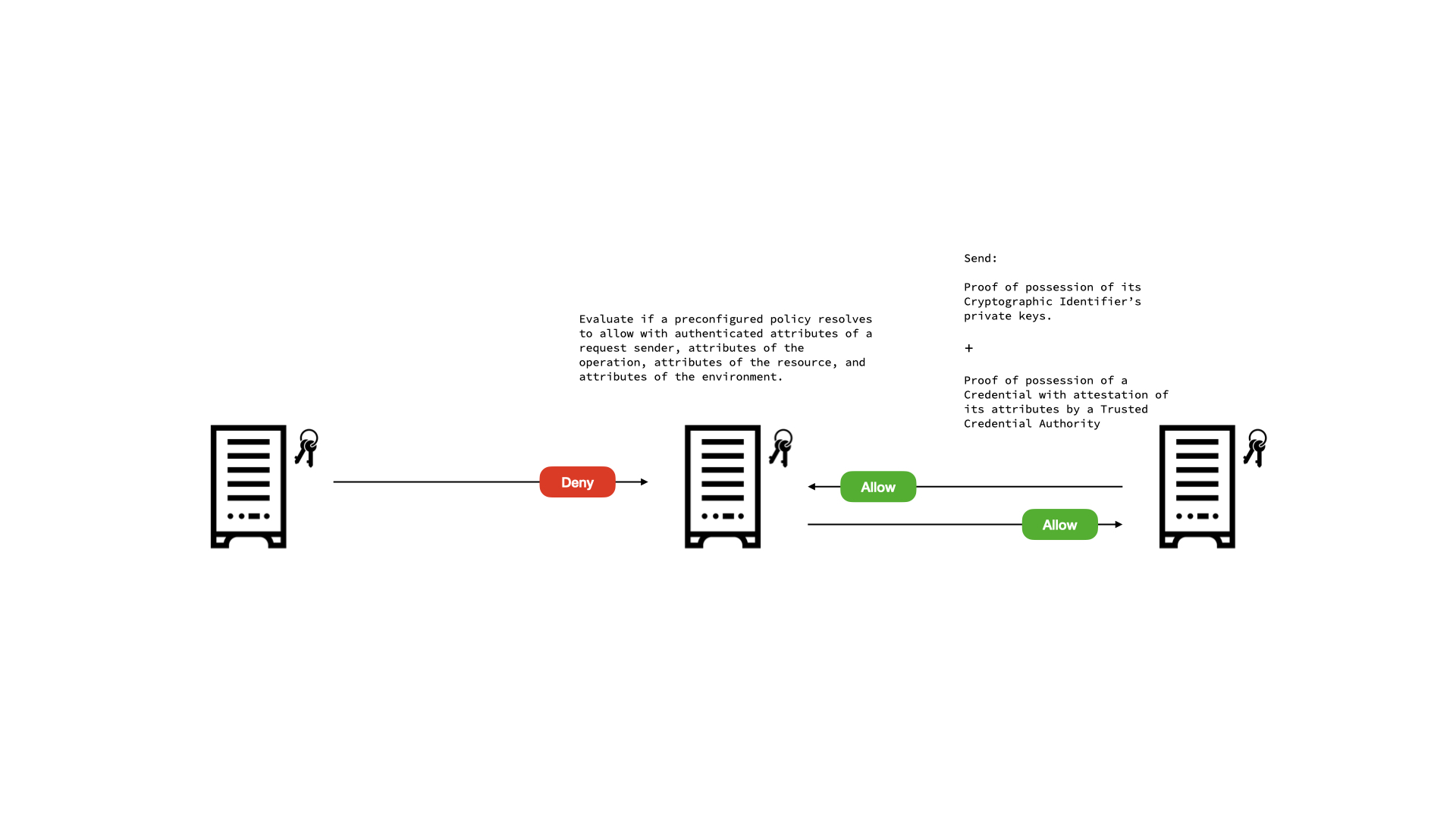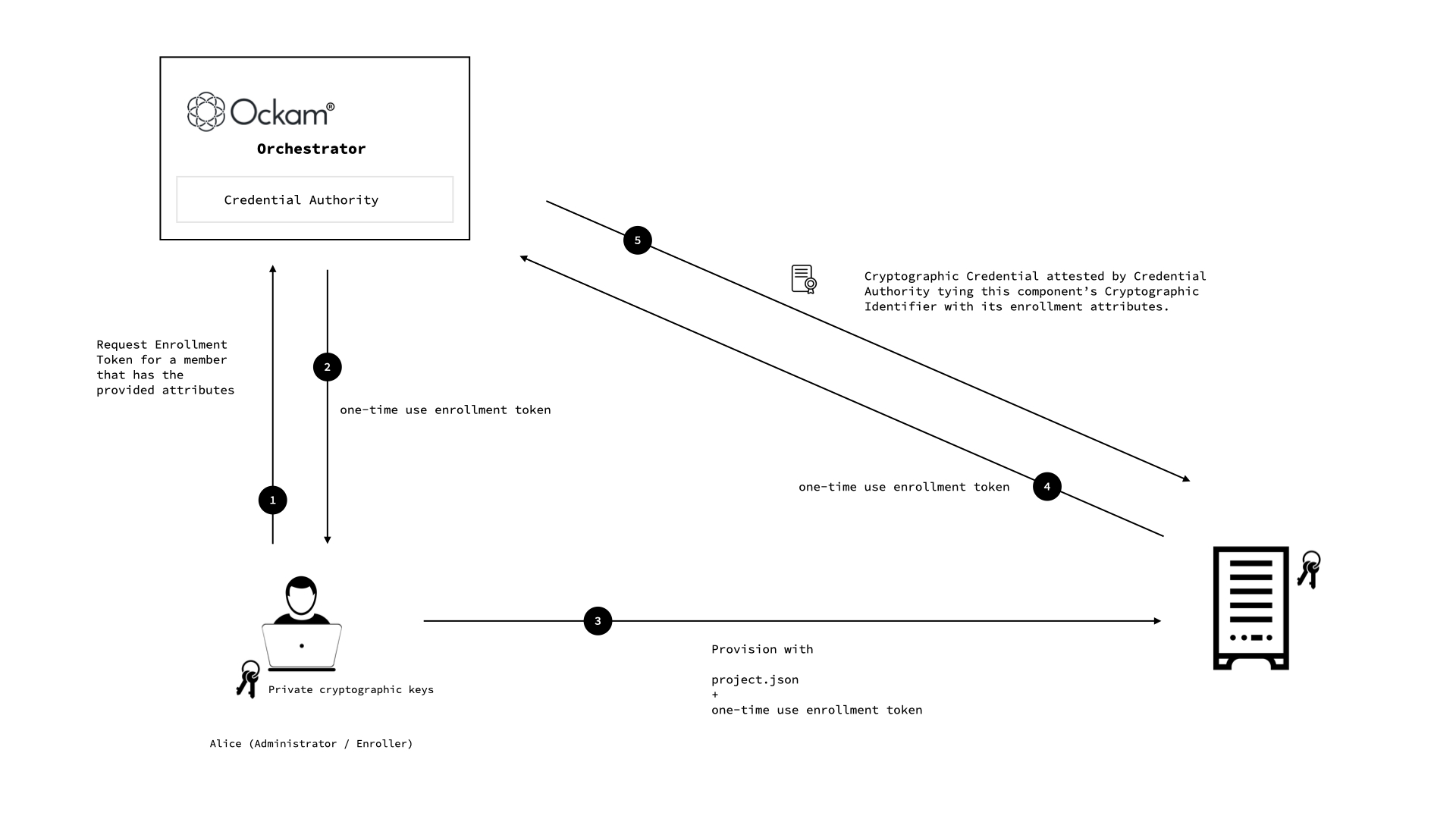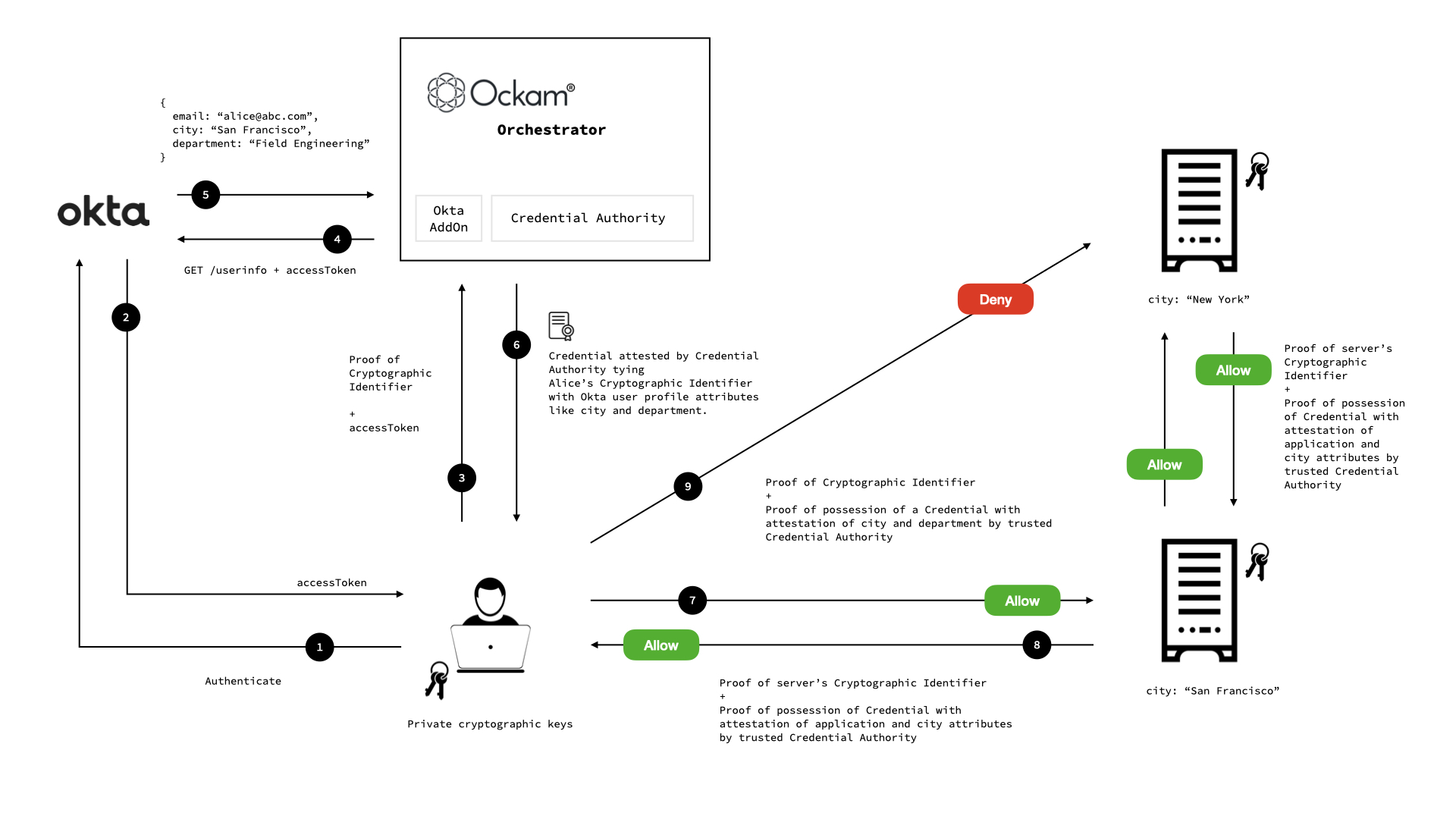Authenticate & authorize every access decision
Nazmul Idris
Published 2023-08-10
In this blog post we will step through a demo of how workforce identities in Okta can be combined with application identities in Ockam. This allows us to bring policy driven, attribute-based access control (ABAC) to distributed applications, using cryptographically verifiable credentials.
What is Ockam?
Ockam is a suite of programming libraries, command line tools, and managed cloud services to orchestrate end-to-end encryption, mutual authentication, key management, credential management, and authorization policy enforcement — all at massive scale. Ockam's end-to-end secure channels guarantee authenticity, integrity, and confidentiality of all data-in-motion at the application layer.
Use employee attributes from Okta to Build Trust with Cryptographically Verifiable Credentials
Modern applications are distributed and have an unwieldy number of interconnections that must trustfully exchange data and instructions.
Authentication is a process where one entity gains assurances about the attributes of another entity. In other words, it is a process of proving that you are who you say you are.
Authorization is the process of deciding if a request to access a resource should be granted. In other words, it is a process that grants you the permission to do the "thing" that you are attempting to do.
The problem and how Ockam simplifies it
Modern applications are distributed and have an unwieldy number of interconnections that must trustfully exchange data and instructions.
In order to trust information or instructions, that are received over the network, applications must authenticate all senders and verify the integrity of data received to assert what was received is exactly what was sent — free from errors or en-route tampering.
Applications must also decide if a sender of a request is authorized to trigger the requested action or view the requested data.
In scenarios where human users are authenticating with cloud services, we have some mature protocols like OAuth 2.0 and OpenID Connect (OIDC) that help tackle parts of the problem. However, the majority of data that flows within modern applications doesn’t involve humans. Microservices interact with other microservices, devices interact with other devices and cloud services, internal services interact with partner systems and infrastructure services etc.
Secure by-design applications must ensure that all machine-to-machine application layer communication is authenticated and authorized. For this, applications must prove identifiers and attributes.
Ockam allows workforce identities in Okta to be combined with application identities in Ockam to bring policy driven, attribute-based access control of distributed applications – using cryptographically verifiable credentials.
Cryptographically Provable Identifiers
Ockam makes it simple to safely generate unique cryptographically provable identifiers and store their private keys in safe vaults. Ockam Secure Channels enable mutual authentication using these cryptographically provable identifiers.
On this foundation of mutually authenticated secure channels that guarantee end-to-end data authenticity, integrity and confidentiality, we give you tools to make fine-grained trust and authorization decisions.
One simple model of trust and authorization that is possible using only cryptographically provable identifiers is Access Control Lists (ACLs). A resource server is given a list of identifiers that it will allow access to a resource through an authenticated channel. This works great for simple scenarios but is hard to scale. As new clients or users need access to this resource, the access control list has to be updated.
A much more powerful and scalable model becomes feasible with cryptographically provable credentials.
Authenticated Attributes and Cryptographic Credentials
When making fine-grained trust and access control decisions, applications often need to reason about the properties or attributes of an entity that is requesting access to a resource or reporting some data. For example, an application may require that its inventory microservice is the only service that is allowed to report the current status of inventory. For this to work, applications need a way to authenticate attributes.
Ockam enables attribute authentication using cryptographically verifiable credentials.
A credential Verifier trusts the public identifier of a credential Authority. A
Prover that wishes to authenticate an attribute to this verifier gets a
cryptographically signed credential from this same credential authority. By issuing a
credential, the authority attests to one or more attributes of the prover. For example the
authority may attest that a particular identifier has the attributes
service-type=inventory, location="New York".
Credentials are issued over mutually authenticated, end-to-end secure channels and carry a cryptographic signature over an authenticated identifier and its attributes. This then allows a verifier to check signatures and authenticate attributes.
Once we have authenticated attributes, a resource owner can make trust decisions based on these attributes rooted in attestations by trusted authorities.
Credential Authorities and Enrollment Protocols
Any Ockam Identifier can issue credentials about another Identifier, however some credential authorities are central to the success and scale of a distributed application. For such authorities Ockam Orchestrator offers highly scalable and secure managed credential authorities as a cloud service.
We also have to consider how credentials are issued to a large number of application entities. Ockam offers several pluggable enrollment protocols. Once simple option is to use one-time-use enrollment tokens. This is a great option to enroll large fleets of applications, services, or devices. It is also easy to use with automated provisioning scripts and tools.
Okta Add-On for Ockam Orchestrator
For most enterprises, workforce identities are already defined in enterprise identity systems like Okta. Ockam Orchestrator offers an Okta Add-On that uses OIDC to allow enterprise employees to get Ockam credentials using their regular corporate login.
Their user profile information like department, city, team etc. is included in the credential and securely attested by the Credential Authority.
This combination is incredibly powerful. It allows employees to get just-in-time, short lived, fine-grained revocable credentials to only the application components that they need to access. It eliminates long lived static keys and credentials from being stored on work machines.
Step-by-Step Walkthrough
Let's walk through a simple example of Okta + Ockam in action.
We have a distributed application which has microservice components running in San Francisco and New York. These components have Ockam Identities and Credentials and communicate trustfully using Ockam Secure Channels.
There is a problem in one of the microservices in San Francisco and we need to give Alice (an engineer from San Francisco) secure, short lived, revocable access to just that service and nothing more.
First we'll create our application components and then see how to give access to Alice.
Required Dependencies
Through this example https://trial-9434859.okta.com/oauth2/default refers to an existing
Okta endpoint where workforce identities are defined. The Okta user profile is expected
to contain email, city and department attributes. These attributes will be included
on the generated Ockam credentials.
If you don't have an Okta install already, you can create a trial account to follow this example use case.
Setup
If you use Homebrew, you can install Ockam using brew.
_10brew install build-trust/ockam/ockam
Otherwise, you can download our latest architecture specific pre-compiled binary by running:
_10curl --proto '=https' --tlsv1.2 -sSf https://raw.githubusercontent.com/build-trust/ockam/develop/install.sh | sh
After the binary downloads, please move it to a location in your shell's $PATH, like
/usr/local/bin.
You can find more information on getting started and installing Ockam here.
Administrator
Next we provision our system. We enroll with Ockam Orchestrator, enable the Okta Add-On and export the project configuration to share with Alice.
_10ockam enroll_10ockam project addon configure okta \_10 --tenant https://trial-9434859.okta.com/oauth2/default --client-id 0oa2pi8no6Kb04frP697 \_10 --attribute email --attribute city --attribute department_10_10ockam project information --output json > project.json
This will create a managed Credential Authority for our project.
Next we generate two one-time-use enrollment tokens to enable Machine 1 and 2 to enroll
and get credentials. Notice how we specify the attributes to attest for these two
machines: city and application. We also specify the name of the relays on orchestrator that these
machines can create: "m1" and "m2" respectively.
_10m1_token=$(ockam project ticket --attribute application="Smart Factory" --attribute city="San Francisco" --relay "m1")_10m2_token=$(ockam project ticket --attribute application="Smart Factory" --attribute city="New York" --relay "m2")
Machine 1 in New York
We'll represent the application service on Machine 1 with a simple http server listening
on port 5000 but this could be any application service:
_10python3 -m http.server --bind 127.0.0.1 5000
Next we transfer project configuration and one enrollment token to Machine 1 and use that to create an Ockam node that will run as a sidecar process next to our application service.
_10ockam identity create m1_10ockam project enroll $m1_token --identity m1_10ockam node create m1 --identity m1_10ockam policy create --at m1 --resource tcp-outlet \_10 --expression '(or (= subject.application "Smart Factory") (and (= subject.department "Field Engineering") (= subject.city "San Francisco")))'_10ockam tcp-outlet create --at /node/m1 --from /service/outlet --to 127.0.0.1:5000_10ockam relay create m1 --at /project/default --to /node/m1
We then set an attribute based policy on the tcp-outlet that delivers traffic to our application service. This policy says to allow requests if the subject (the entity requesting access) is part of the same application or if the subject is a Field Engineer based in San Francisco.
_10(or (= subject.application "Smart Factory")_10 (and (= subject.department "Field Engineering") (= subject.city "San Francisco")))
The first part of the policy allows various application component services to communicate with each other. The second part is what will enable Alice. However, note that there is no mention of Alice here, only a department and a city.
Machine 2 in San Francisco
We'll represent the application service on Machine 2 with a simple http server listening
on port 6000 but this could be any application service:
_10python3 -m http.server --bind 127.0.0.1 6000
Next we transfer project configuration and one enrollment token to Machine 2 and use that to create and Ockam node that will run as a sidecar process next to our application service.
_10ockam identity create m2_10ockam project enroll $m2_token --identity m2_10ockam node create m2 --identity m2_10ockam policy create --at m2 --resource tcp-outlet \_10 --expression '(or (= subject.application "Smart Factory") (and (= subject.department "Field Engineering") (= subject.city "New York")))'_10ockam tcp-outlet create --at /node/m2 --from /service/outlet --to 127.0.0.1:6000_10ockam relay create m2 --at /project/default --to /node/m2
Same as before, we then set an attribute based policy on the the tcp-outlet that delivers traffic to our application service. This policy says to allow requests if the subject (the entity requesting access) is part of the same application or if the subject is a Field Engineer based in New York.
_10(or (= subject.application "Smart Factory")_10 (and (= subject.department "Field Engineering") (= subject.city "New York")))
Engineer for San Francisco
There is a problem in one of the microservices in San Francisco and we need to give Alice (an engineer from San Francisco) secure, short lived, revocable access to just that service and nothing more.
Since the Okta Add-On is enabled. Alice can simply start a node within the project and authenticate.
_10ockam project enroll --project-path project.json --okta_10ockam node create alice_10ockam policy create --at alice --resource tcp-inlet --expression '(= subject.application "Smart Factory")'
The project enroll command will launch Okta login and when it completes return an Ockam
cryptographic credential that includes the city and department attributes of Alice's
profile in Okta Universal Directory. Only these two attributes are attested because the
administrator specified those two attributes when enabling the Okta Add-On.
Alice's city in Okta is "San Francisco". Her request to access Machine 1 in San
Francisco is allowed.
_10ockam tcp-inlet create --at /node/alice --from 127.0.0.1:8000 \_10 --to /project/default/service/forward_to_m1/secure/api/service/outlet_10curl --head 127.0.0.1:8000
Her request to access Machine 2 in New York is denied.
_10ockam tcp-inlet create --at /node/alice --from 127.0.0.1:9000 \_10 --to /project/default/service/forward_to_m2/secure/api/service/outlet_10curl --head 127.0.0.1:9000_10_10# this will do nothing and eventually timeout
When new employees join the Field Engineering team in San Francisco, they will get an Okta workforce identity and can also request access to services they are responsible for in San Francisco without any change to the system.
Next steps
Ockam and Okta allow attribute based policies to easily span the spectrum of "very simple" to "highly fine-grained and dynamic" depending on the needs of an application. At the same time, this approach is highly scalable because it decouples enterprise identity administration from an application's trust policies.
Here are some good jumping off points to learn more about Ockam:
- Install Ockam command line interface (CLI)
(
ockamcommand) on your computer and try to create end-to-end encrypted communication between two apps. - Learn about other use cases where Ockam can help secure your infrastructure with ease.
Previous Article
Call a private API
Next Article
Ockam Routing




